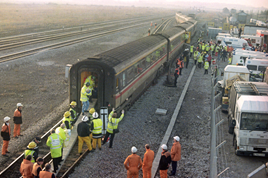Because the signal had not been changed by the signalman (and nor had he given authorisation for the Sprinter to pass the signal at danger), evidence was heard that a possibility existed (although highly unlikely) that the signal could have been cleared at the critical moment by technicians working in a relay room at Severn Trent Junction, resetting the axle counters that had suffered a malfunction two days earlier.
Signalling experts disagreed over whether this could have happened when the axle counter was disabled, and so the inquiry could not draw any firm conclusion. The only other reasonable explanation was an ‘unaccountable error’ on the part of Carpenter, who did not give evidence to either confirm or deny having passed the signal at danger without first seeking authorisation from the signalman.
The final accident report also heavily criticised the effectiveness of the emergency response, finding that although the emergency planning was perfectly adequate, its implementation was not.
A depressing catalogue of errors was exposed, starting with the breaking of the tell-tale wire being wrongly interpreted at Newport signal box as a technical failure rather than a genuine emergency, due to a history of false alarms. The precise location reported by the HST driver was then not properly communicated in the early stages, before most of the pagers issued to the BR rescue team based at Sudbrook failed due to lack of maintenance or not being switched on.
The delays in getting the Sudbrook train into the tunnel and then the HST out were caused by the need to obtain authority to pass a signal at danger under the tunnel’s emergency procedures, and the signalman having to liaise with emergency services occupying the tunnel in an area known for poor radio coverage.
The signalman’s decision to withdraw the handsignalmen before the collision was also dismissed as “improper”, although it was recognised that the use of a handsignalman is a convenience rather than a necessity, to enable a driver to be given authorisation to pass a signal at danger without having to leave the cab and phone the signalman themselves.
The accident report’s recommendations, therefore, were that wherever axle counters were used BR should make provision for resetting to be placed under the control of the signalman (rather than technicians), and that improved means should be provided for isolating them from the signalling system.
BR was also required to review the emergency procedures for the tunnel area, to ensure objectives are clearly established and state of preparedness regularly monitored.
No obvious contravention of any Health and Safety legislation was found, and the tunnel’s excellent safety record was commended - only two minor train accidents had been recorded in over a century of operation.
That impressive record has thankfully continued unblemished since the events of December 7 1991.
















Login to comment
Comments
No comments have been made yet.